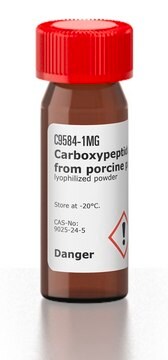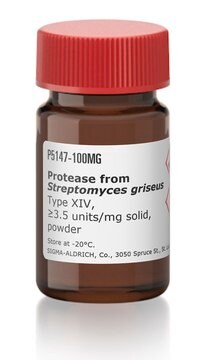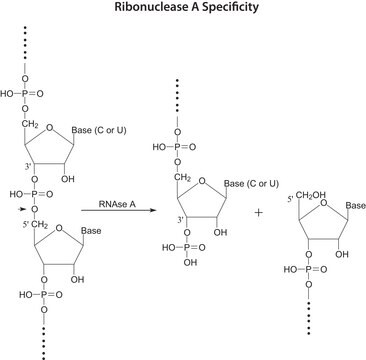C3805
Cyclophilin A human
≥95% (SDS-PAGE), recombinant, expressed in E. coli, buffered aqueous solution
Synonym(s):
CyP
Sign Into View Organizational & Contract Pricing
All Photos(1)
About This Item
CAS Number:
MDL number:
UNSPSC Code:
12352204
NACRES:
NA.54
Recommended Products
biological source
human
Quality Level
recombinant
expressed in E. coli
Assay
≥95% (SDS-PAGE)
form
buffered aqueous solution
mol wt
20 kDa
concentration
≥0.3 mg/mL
technique(s)
cell culture | mammalian: suitable
UniProt accession no.
storage temp.
−20°C
Gene Information
human ... PPIA(5478)
General description
Cyclophilins are a family of extremely conserved proteins, known as immunophilins. Cyclophilin A (CyPA) is present in all tissues in prokaryotes and eukaryotes. It is present in all organs of human. Cyclophilin A (CyPA), a 20 kDa chaperone protein, that is liberated from vascular smooth muscle cells (VSMCs).
Application
Cyclophilin A human has been used in the study to interpret the mechanisms by which extracellular CyPA initiates endothelial activation.
Biochem/physiol Actions
Cyclophilin A (CyPA) participates in intracellular signalling and protein trafficking. It helps to control other proteins activity. CyPA plays a physiological and pathological role in cardiovascular diseases. Hence it acts as an important biomarker and mediator in several cardiovascular diseases, like vascular stenosis, atherosclerosis and abdominal aortic aneurysms. CyPA can induce the proliferation and inflammatory cell migration of vascular smooth muscle cells (VSMC) in vitro and in vivo.
Cyclophilins are peptidyl prolyl isomerases that catalyze the cis-trans isomerization of X-Pro peptide bonds. They are highly-conserved cytoplasmic enzymes that accelerate protein folding and facilitate HIV infectivity. Cyclosporin A binds to cyclophilin and inhibits its activity. The cyclosporin A-cyclophilin complex binds to calcineurin and inhibits T-cell activation. The structure of human, recombinant cyclophilin is given by Holzman, et al.
Physical form
Composed of amino acids 1-165 plus an N-terminal 20 amino acid His-tag
Solution in 20mM Tris, pH 8.0, containing 20 mM NaCl, 0.5 mM DTT and 10% glycerol
Storage Class Code
10 - Combustible liquids
WGK
WGK 1
Flash Point(F)
Not applicable
Flash Point(C)
Not applicable
Personal Protective Equipment
dust mask type N95 (US), Eyeshields, Gloves
Certificates of Analysis (COA)
Search for Certificates of Analysis (COA) by entering the products Lot/Batch Number. Lot and Batch Numbers can be found on a product’s label following the words ‘Lot’ or ‘Batch’.
Already Own This Product?
Find documentation for the products that you have recently purchased in the Document Library.
Atsushi Kumanogoh et al.
Nature reviews. Immunology, 13(11), 802-814 (2013-12-10)
Semaphorins were originally identified as axon-guidance molecules that function during neuronal development. However, cumulative evidence indicates that semaphorins also participate in immune responses, both physiological and pathological, and they are now considered to be potential diagnostic and/or therapeutic targets for
Nikhil Raghuram et al.
The Journal of cell biology, 203(1), 57-71 (2013-10-09)
Histone H1 plays a crucial role in stabilizing higher order chromatin structure. Transcriptional activation, DNA replication, and chromosome condensation all require changes in chromatin structure and are correlated with the phosphorylation of histone H1. In this study, we describe a
Cyclophilin A
Satoh K, et al.
Circulation Journal, 74(11), 2249-2256 (2010)
Roger van Kruchten et al.
Blood, 121(10), 1850-1857 (2013-01-11)
Scott syndrome, a bleeding disorder caused by defective phospholipid scrambling, has been associated with mutations in the TMEM16F gene. The role of TMEM16F in apoptosis- or agonist-induced phosphatidylserine (PS) exposure was studied in platelets from a Scott syndrome patient and
Päivi Pihlajamaa et al.
The EMBO journal, 33(4), 312-326 (2014-01-24)
Androgen receptor (AR) binds male sex steroids and mediates physiological androgen actions in target tissues. ChIP-seq analyses of AR-binding events in murine prostate, kidney and epididymis show that in vivo AR cistromes and their respective androgen-dependent transcription programs are highly
Our team of scientists has experience in all areas of research including Life Science, Material Science, Chemical Synthesis, Chromatography, Analytical and many others.
Contact Technical Service






